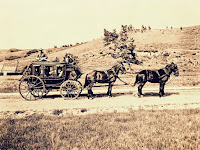 Twenty Minutes. In twenty minute’s of today's time, you can drive the same distance as two stage stops--an equivalent of twenty miles, which in the 1850’s would have taken you four hours plus the layover as the coach's team was changed out at the first stop. The usual distance to run the six horses pulling the stagecoach was no more than ten miles. Rebecca Baylor Rusk met her beloved Marcus on a such a ride in Texas between Clarksville to Jefferson. That’s in book seven, AT LIBERTY TO LOVE.
Twenty Minutes. In twenty minute’s of today's time, you can drive the same distance as two stage stops--an equivalent of twenty miles, which in the 1850’s would have taken you four hours plus the layover as the coach's team was changed out at the first stop. The usual distance to run the six horses pulling the stagecoach was no more than ten miles. Rebecca Baylor Rusk met her beloved Marcus on a such a ride in Texas between Clarksville to Jefferson. That’s in book seven, AT LIBERTY TO LOVE.Prior to those swaying, bouncing, dusty modes of travel, one horse rider would never push his animal more than twenty miles a day if he planned on doing any travel the next. That same twenty minutes would be twelve to fifteen hours horseback including stops to water and grain the horse. Book Two, HEARTS STOLEN, Levi and Wallace rode from Austin all the way to Clarksville on horseback, but they were accompanying a wagon for Rosealeen “Sassy” or “Rose” and Charley that slowed them down.

Now with a wagon load pulled by two mules, like taking a cotton harvest to market, you’d need to plan on two days, ten miles per day to cover the same distance unless you didn’t care about your animals. But a mule’s too smart to be driven to go unto death. He’ll lay down on you, while a horse with run as long you drive him until he falls over dead. In VOW UNBROKEN, book one of the Texas Romance family saga, Henry helped Sue take her crop to market on the Jefferson Trace.
Now it’s been reported that Julius Caesar marched one of his armies eighteen miles a day for five consecutive days. The men carried a five-pound pack. But the men were young, fit, experienced, and had the general’s promise of three days off at the end of their march. It took Lacey Rose two days to get from Clarksville, Texas to DeKalb, Texas in book JUST KIN, book six, but a friend gave her a lift part of the way on his timber wagon.
Once upon a time, a goodly portion of the population never ventured more than twenty miles in any direction their whole lives. Too costly, and most all their friends and family lived close by. Stages and trains changed that to some degree, but it wasn’t until the automobile—Henry Ford’s being the first affordable to the middle class.
So next time you jump behind the wheel, you might want to consider how blessed you are. That other than gas in your tank and your favorite traveling beverage, you gave no thought toward extra horseshoes, grain, feed, or water as those folks not too many generations ago.
Please read about all these modes of 19th century travel in my Texas Romance Family Saga Series! AT LIBERTY TO LOVE is FREE TODAY! Grab your copy NOW!
When's your next ride? Where are you going?
BIO: Caryl McAdoo loves writing stories for all ages that glorify God and is thrilled Christian fiction fits her life purpose so well. Bold not bashful, she’s quick to share the Bible principles she lives by through her characters and hopes each title ministers His love, mercy, and grace. Known as the “Singing Pray-er”—with a YouTube channel to prove it—the prolific hybrid author also loves praising Him with new songs He gives her. Her high-school-sweetheart-husband moved the family from the DFW area—home for fifty-plus years—to the woods and seat of Red River County. After Ron, Caryl counts four children and sixteen grandsugars life’s biggest blessings. The McAdoos live a few miles south of Clarksville in the far northeast corner of the Lone Star State with two grandsons.
Links :





Thanks for breaking it down. Very helpful.Doris
ReplyDeleteReally interesting! Thanks for sharing!
ReplyDeleteVery interesting. I love perspective articles.
ReplyDeleteI watch Murdoch Mysteries (set in Toronto at the turn of the 20th century). A day trip on the train could take them to Guelph--a trip that, barring traffic, takes me an hour and a half at most. That same 1-2 hours would have taken them to the townships which are now part of the Greater Toronto Area.
However, if it's rush hour, it might take us the same amount of time to travel the same distances.